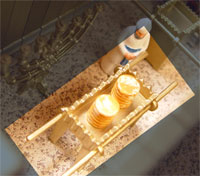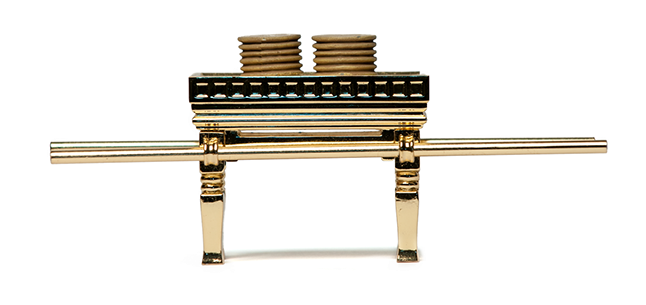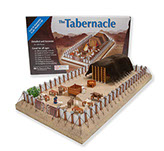<< Previous: Menorah
Next: Altar of Incense >>
The Table of Showbread

There was only one gate by which people could enter into the tabernacle courtyard. The gate was 30 feet wide. It was located directly in the center of the outer court on the east end. The gate was covered by a curtain or screen made of finely twisted linen in blue, purple and scarlet.
The table of showbread was a small table made of acacia wood and overlaid with pure gold. It measured 3 feet by 1.5 feet and was 2 feet, 3 inches high. It stood on the right side of the Holy Place across from the lampstand and held 12 loaves of bread, representing the 12 tribes of Israel. The priests baked the bread with fine flour and it remained on the table before the Lord for a week; every Sabbath day the priests would remove it and eat it in the Holy Place, then put fresh bread on the table. Only priests could eat the bread, and it could only be eaten in the Holy Place, because it was holy.

“Showbread” also was called “bread of the presence” because it was to be always in the Lord’s presence. The table and the bread were a picture of God’s willingness to fellowship and communion (literally speaking, sharing something in common) with man. It was like an invitation to share a meal, an extension of friendship. Eating together often is an act of fellowship. God was willing for man to enter into His presence to fellowship with Him, and this invitation was always open.
Jesus exemplified this when He ate with tax collectors, prostitutes and the sinners of Jewish society. But this was more than just a gesture of friendship on earth. Jesus came to call sinners to Him, make them right with God, so that they could enjoy everlasting fellowship with God.
Purchase a Tabernacle Model Kit
A great visual aid for teaching about the tabernacle with adults and children.

“I am the bread of life. He who comes to me will never go hungry, and he who believes in me will never be thirsty. … Your forefathers ate the manna in the desert, yet they died. But here is the bread that comes down from heaven, which a man may eat and not die.” (John 6:35, 49-50)
God so desires our fellowship that He was willing to come to earth from heaven as our “bread of life” to give eternal life to all those who would partake in it. At Jesus’ last Passover meal with His disciples, Jesus described Himself as bread again:
“While they were eating, Jesus took bread, gave thanks and broke it, and gave it to his disciples, saying, ‘Take and eat; this is my body.’” (Matthew 26:26)
Jesus’ broken body is our only access to fellowship with God. Today, we celebrate the Lord’s Supper, or communion, to remember this important truth. And today, as in the day of Moses’ tabernacle, God still desires to have fellowship and sit down for a feast with His people.

“Here I am! I stand at the door and knock. If anyone hears my voice and opens the door, I will come in and eat with him, and he with me.” (Revelations 3:20)
<< Previous: Menorah
Next: Altar of Incense >>
What is the Tabernacle of Moses?
- Diagrams of the Tabernacle and Basic Layout
- The Gate
- The Brazen Altar
- The Laver
- The Menorah
- The Table of Showbread
- The Golden Altar of Incense
- The Ark of the Covenant and Atonement Cover
Why Study the Tabernacle of Moses?
Why the Jewish Old Testament Tabernacle?
Sunday School Lessons on the Tabernacle
I WANT TO LEARN
ABOUT GOODSEED
The Monthly
GoodSeed eNewsletter
Sign up to receive articles, testimonies, sneak peeks of new resources & upcoming seminars. You'll receive a PDF copy of The Tabernacle: Model of Messiah as a thank you for partnering with us.
© 2023 GoodSeed International. All rights reserved.


